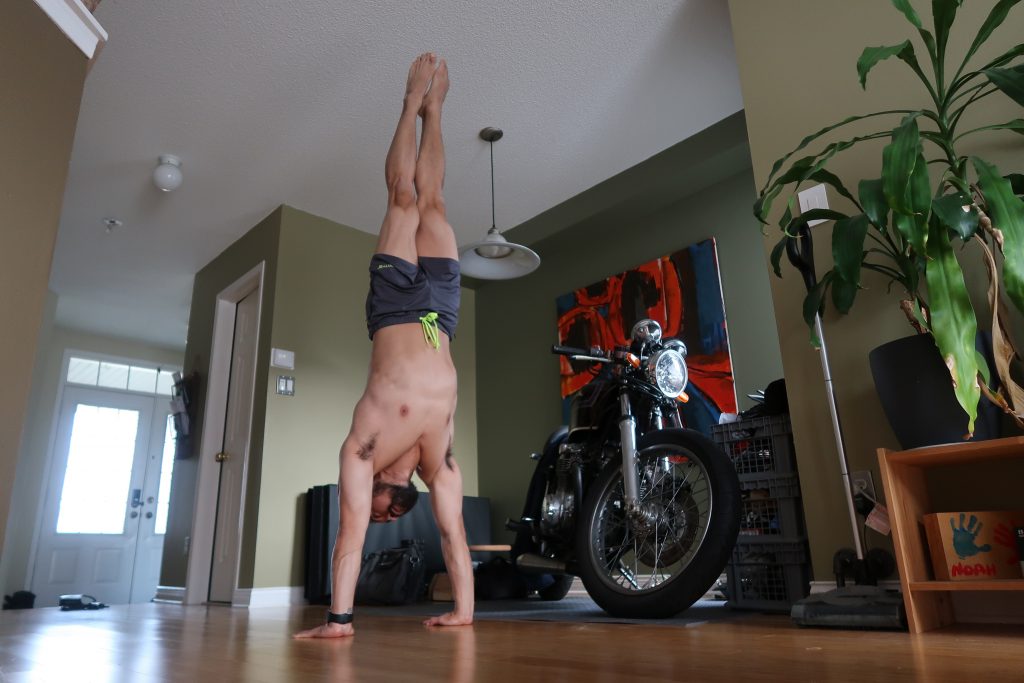 One thing I took away from being a gymnast in my youth is the discipline of conditioning and stretching. It was never my favorite part of my gymnastic lessons but now I feel that it can help rebuild my body to a workable state. Gymnastic closely resembles calisthenics. The word calisthenics comes from the Greek words kallos (beauty) and sthenos (strength). Indeed, there’s a timeless beauty to training for strength and flexibility via pushing, pulling, lunging, and lifting movements using little to no equipment. When performed in a continuous, rigorous fashion, calisthenics train up your strength and aerobic capacity.
One thing I took away from being a gymnast in my youth is the discipline of conditioning and stretching. It was never my favorite part of my gymnastic lessons but now I feel that it can help rebuild my body to a workable state. Gymnastic closely resembles calisthenics. The word calisthenics comes from the Greek words kallos (beauty) and sthenos (strength). Indeed, there’s a timeless beauty to training for strength and flexibility via pushing, pulling, lunging, and lifting movements using little to no equipment. When performed in a continuous, rigorous fashion, calisthenics train up your strength and aerobic capacity.
In addition to the various stretches, some of the more common calisthenic exercises include:
Handstand – A handstand is the act of supporting the body in a stable, inverted vertical position by balancing on the hands. In a basic handstand the body is held straight with arms and legs fully extended, with hands spaced approximately shoulder-width apart.
Muscle-ups – One of the basic calisthenics routines. Performed by a combination routine of a pull-up followed by a dip. May be done on pullup bars or rings.
Squat jumps (“Toyota jumps”/box jumps) – Performed by entering a squatting position, then using a plyometric jumping movement to jump as high as possible.
Front Lever – A front lever is performed by lowering from an inverted hang until the body is completely horizontal and straight with the front of the body facing upwards. May be done on rings or pull-up bar.
Push-ups – Performed face down on the floor, palms against floor under the shoulders, toes curled upwards against the floor. The arms are used to lift the body while maintaining a straight line from head to heel. The arms of the subject should go from fully extended in the high position to nearly fully flexed in the low position, while the subject makes sure to avoid resting on the floor. Resting is only done in the high position of the exercise. Chest, shoulders, and triceps are trained with this exercise. By furthering the range of motion, what is often called a push up, by pushing the shoulders downwards at the top the serratus anterior comes further into play.
Pull-ups – An overhead bar (sometimes called a chin-up bar) is grasped using a shoulder-width grip. The subject lifts their body up, chin level with the bar, and keeping the back straight throughout. The bar remains in front of the subject at all times. The subject then slowly returns to starting position in a slow controlled manner. This primarily trains the lats or upper back muscles, as well as the forearms. An underhand grip variation or chin-up trains both the back and biceps.
Chin-ups – Much like the pull-up, except that the hand placement is reversed. The hands are facing the person as he pulls his body up using the chin-up bar. The chin-up focuses on the biceps muscles, rather than the Latissimus dorsi muscle which is the focus of the pull up.
Squats – Standing with feet shoulder width apart, the subject squats down as far as possible, bringing the arms forward parallel to the floor. The subject then returns to standing position. Squats train the quadriceps, hamstrings, calves, and gluteal muscles.
Back Lever – A back lever is performed by lowering from an inverted hang from rings or bar, until the gymnast’s body is parallel to the ground and facing towards the floor.
Dips – Done between parallel bars or facing either direction of trapezoid bars found in some gyms. Feet are crossed with either foot in front and the body is lowered until the elbows are in line with the shoulders. The subject then pushes up until the arms are fully extended, but without locking the elbows. Dips focus primarily on the chest, triceps, and deltoids, especially the anterior portion.
Hyperextensions – Performed in a prone position on the ground, the individual raises the legs, arms and upper body off the ground.
Leg raises – Lying on the back, hands in fists under buttocks, move feet up and down.
Planks – This is the name for holding the ‘top’ position of a push-up for extended periods of time. The primary muscle involved in this exercise is the rectus abdominis.
Shuttle runs – This is running back and forth between two points (or cones) typically separated by 5-40 meters, as fast as possible, with a touchdown. The emphasis should be on stopping, turning back and accelerate back to a sprint as quickly as possible.
Burpees – A full body calisthenics workout that works abdominal muscles, chest, arms, legs, and some parts of the back.


